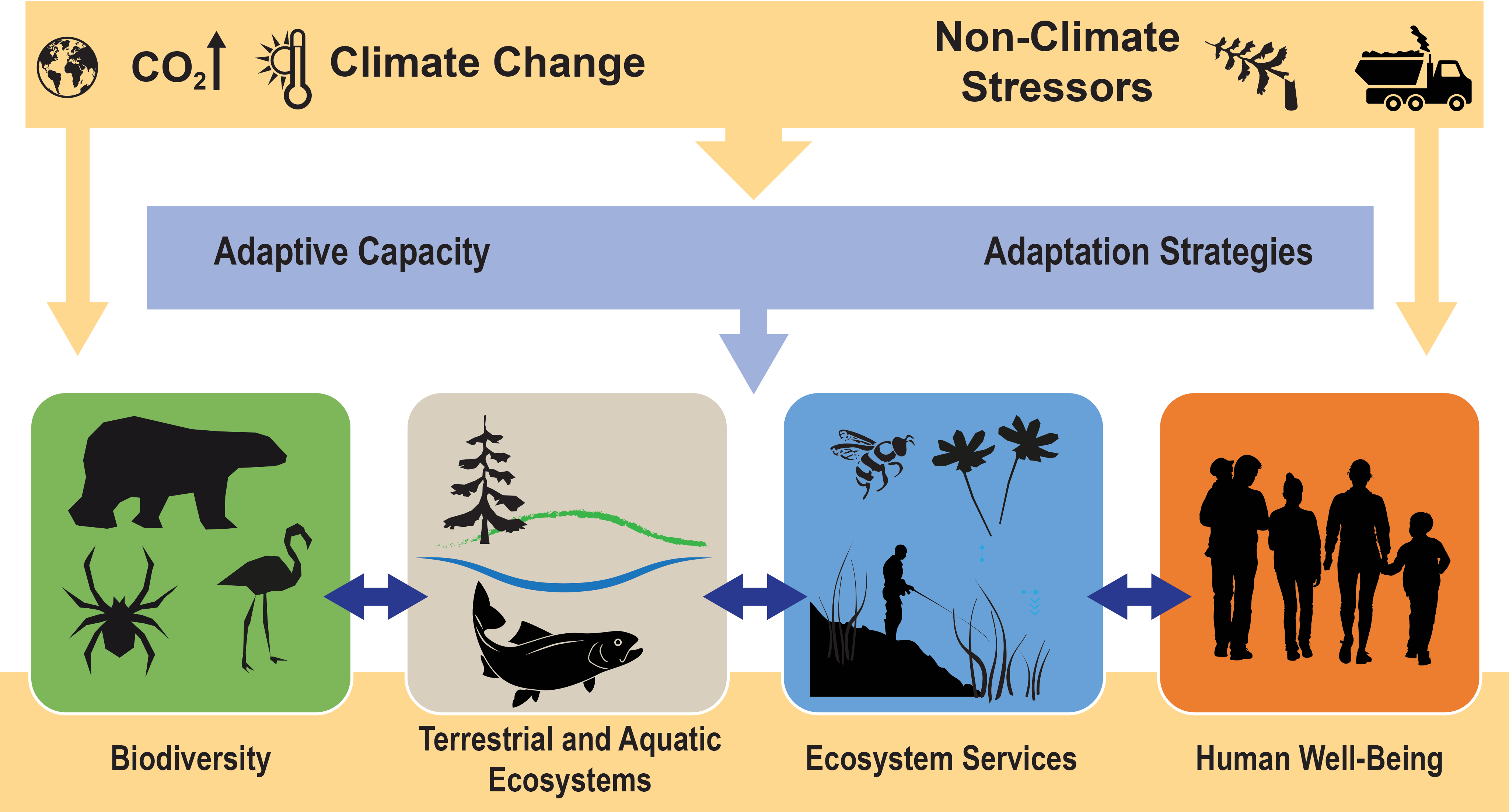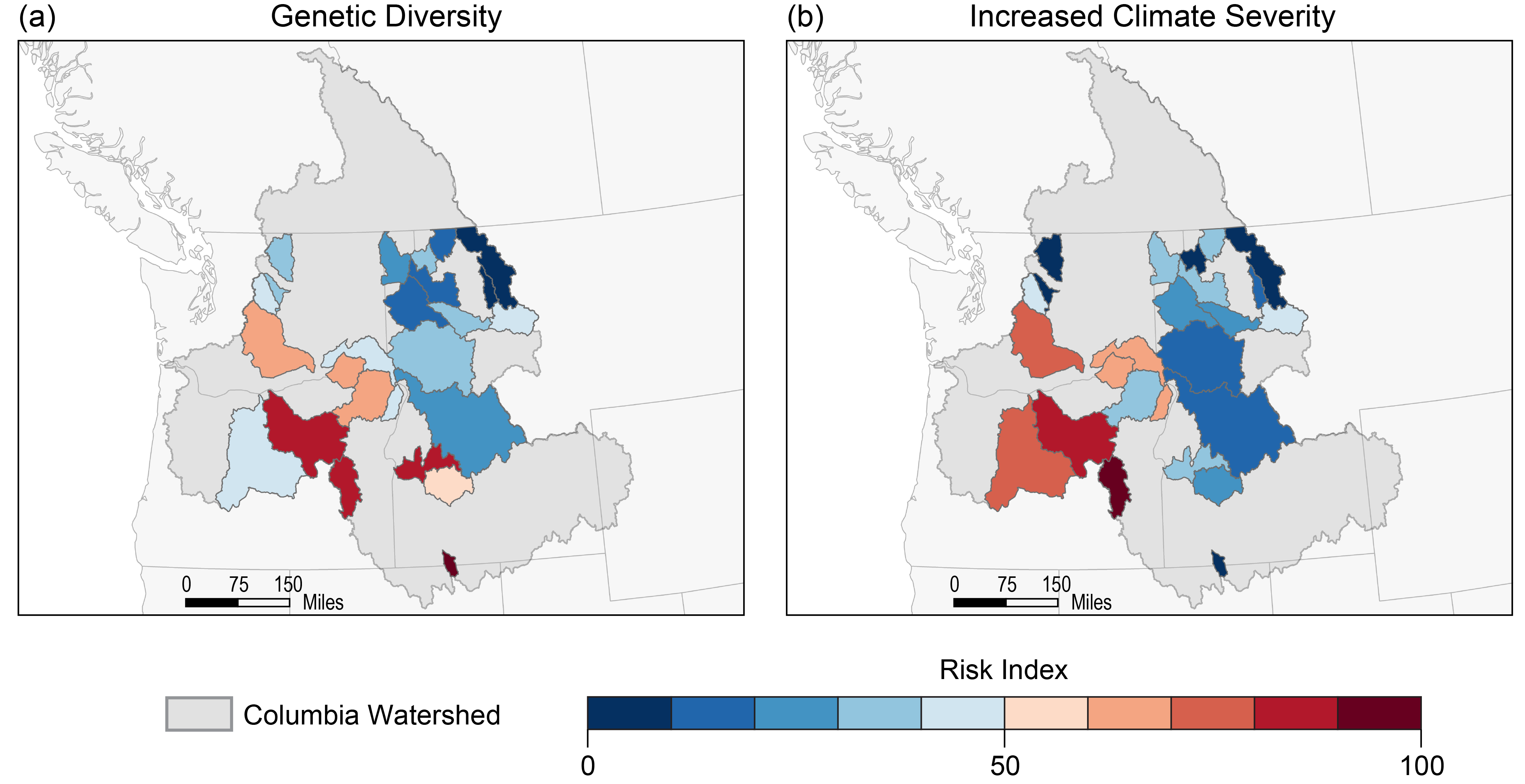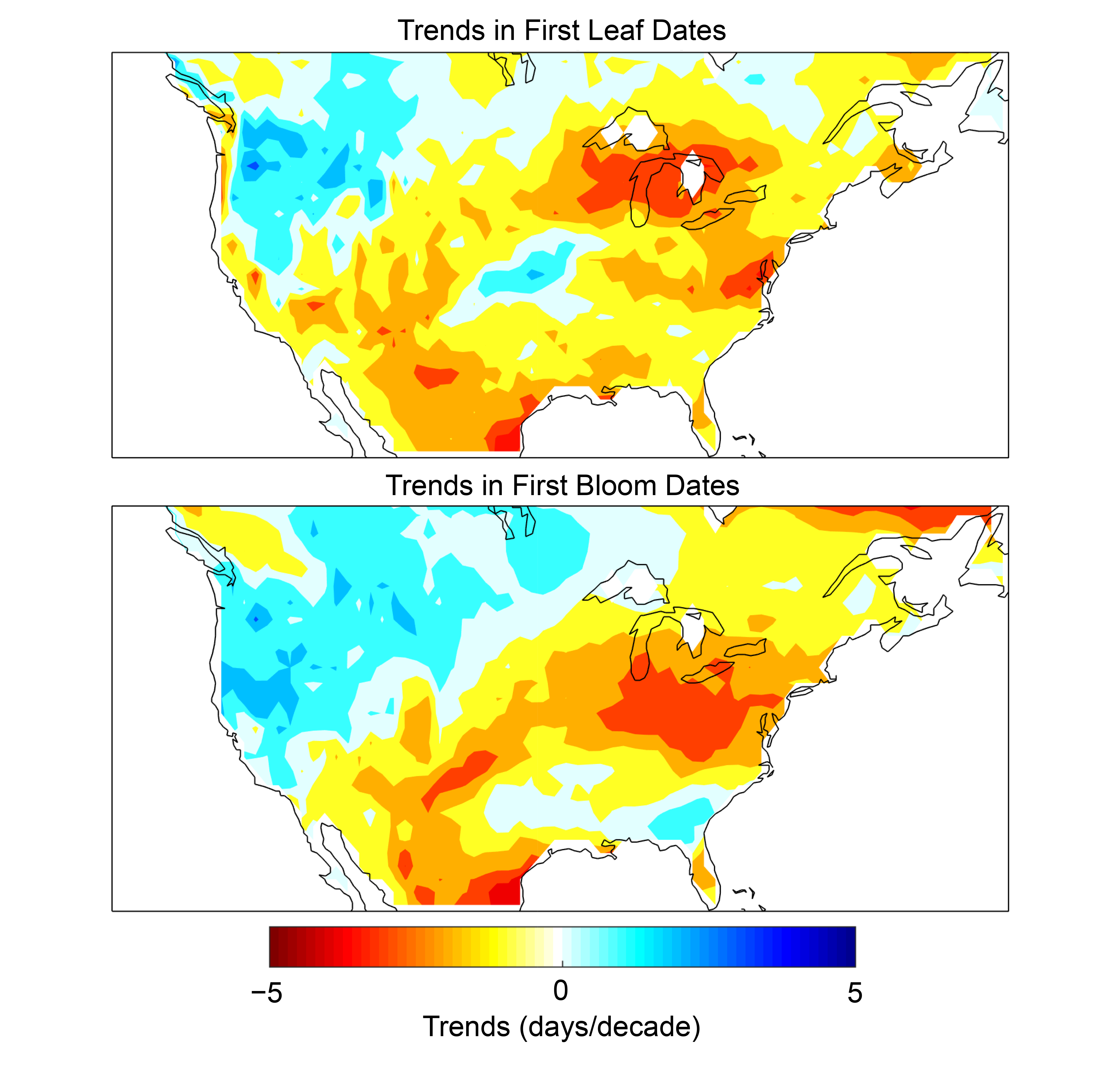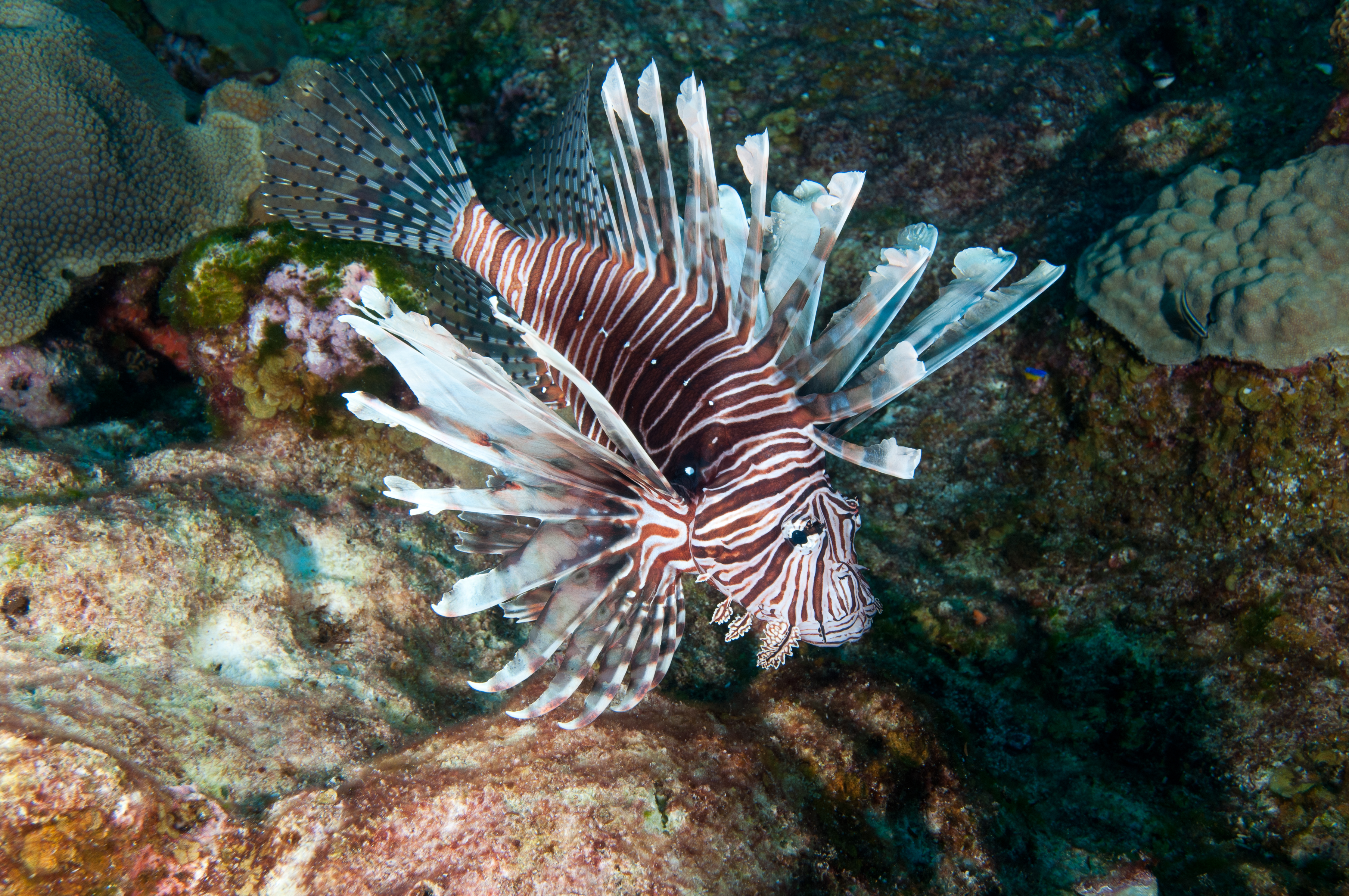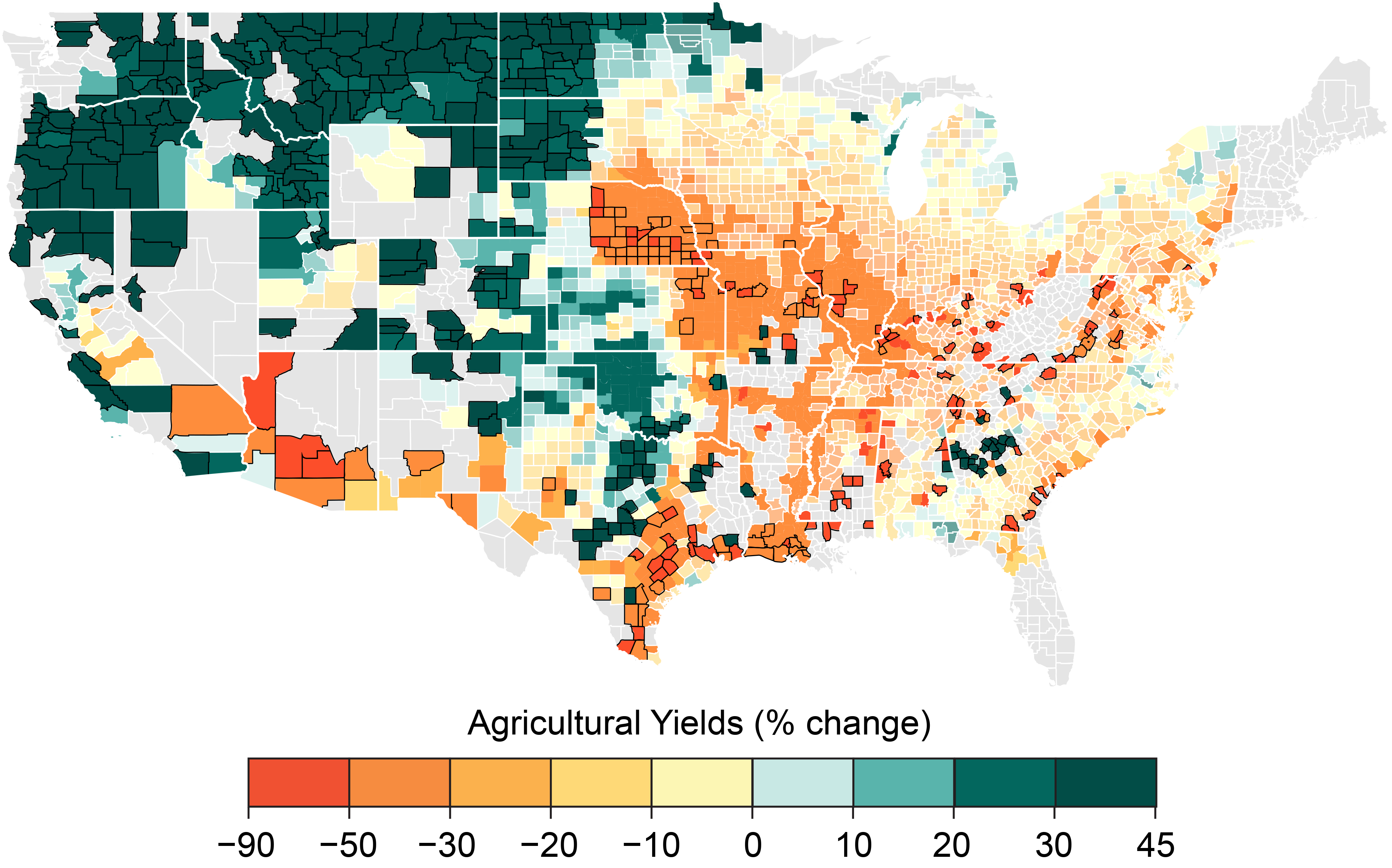Topics for the chapter were selected to improve the consistency of coverage of the report and to standardize the assessment process for ecosystems and biodiversity. Chapter leads went through the detailed technical input for the Third National Climate Assessment and pulled out key issues that they felt should be updated in the Fourth National Climate Assessment. The chapter leads then came up with an author team with expertise in these selected topics. To ensure that both terrestrial and marine issues were adequately covered, most sections have at least one author with expertise in terrestrial ecosystems and one with expertise in marine ecosystems.
Monthly author calls were held beginning in December 2016, with frequency increasing to every other week as the initial chapter draft deadline approached. During these calls, the team came up with a work plan and fleshed out the scope and content of the chapter. After the outline for the chapter was created, authors reviewed the scientific literature, as well as the technical input that was submitted through the public call. After writing the State of the Sector section, authors pulled out the main findings to craft the Key Messages.
Key Message 1: Impacts on Species and Populations
Climate change continues to impact species and populations in significant and observable ways (high confidence). Terrestrial, freshwater, and marine organisms are responding to climate change by altering individual characteristics, the timing of biological events, and their geographic ranges (likely, high confidence). Local and global extinctions may occur when climate change outpaces the capacity of species to adapt (likely, high confidence).
Description of evidence base
Changes in individual characteristics: Beneficial effects of adaptive capacity depend on adequate genetic diversity within the existing population and sufficient population sizes. In addition, successful adaptive responses require relatively slow or gradual environmental change in relation to the speed of individual or population-level responses.13 Empirical evidence continues to suggest that plastic changes and evolution have occurred in response to recent climate change10,11,12,233 and may be essential for species’ persistence.186,234,235 However, adaptation is only possible if genetic diversity has not already been eroded as a result of non-climate related stressors such as habitat loss.15 Additionally, projections suggest that climate change may be too rapid for some species to successfully adapt.35,236 Adaptive capacity, and by extension the ability to avoid local or even global extinctions, is likely to vary among species and even populations within species.
Changes in range: Shifts in species’ ranges have been documented in both terrestrial and aquatic ecosystems as species respond to climate change.35,39 Approximately 55% of terrestrial and marine plant and animal species studied in temperate North America have experienced range shifts.35 Climate change has led to contractions in the latitudinal or elevational ranges of 41% (97 of 238) of studied terrestrial plant and animal species in North America and Hawaiʻi in the last 50–100 years.35 Range shifts in terrestrial animal communities average 3.8 miles per decade.107 In marine communities, range shifts of up to 17.4 miles per decade have been documented.17 Planktonic organisms in the water column (that is, passively floating organisms in a body of water) more closely track the trajectory of preferred environmental conditions, resulting in more extensive range shifts; these organisms have exhibited rates of change from 4.3 miles per decade for species with broad environmental tolerances to 61.5 miles per decade for species with low tolerance of environmental change over a 60-year period.237 Walsh et al. 2015 38 documented significant changes in the center of distribution over two decades of 43% of planktonic larvae of 45 fish species.
These shifts have been linked to climate velocity—the rate and direction of change in temperature patterns.30,39,238,239 Marked differences in observed patterns of climate velocity in terrestrial and aquatic ecosystems have been observed.29,240 Climate velocity in the ocean can be greater than that on land by a factor of seven.17
Changes in phenology: In marine and freshwater systems, the transition from winter to spring temperatures is occurring earlier in the year, as evidenced by satellite measures of sea surface temperature dating back to 1981.23 In addition, the timing of sea ice melt is occurring earlier in the spring at a rate of about 2 days per decade and has advanced by 25–30 days since 1979 in some regions.24 Shifts in phenology have been well documented in terrestrial, marine, and freshwater systems.113 As with range shifts, changes to phenology are expected to continue as the climate warms.114
Extinction risks: The rate and magnitude of climate impacts can exceed the abilities of even the most adaptable species, potentially leading to tipping points and abrupt system changes. In the face of rapid environmental change, species with limited adaptive capacity may experience local extinctions or even global extinctions.126,127
Major uncertainties
Changes in individual characteristics: Species and populations everywhere have evolved in response to reigning climate conditions, demonstrating that evolution will be necessary to survive climate change. Nonetheless, there is very limited evidence for evolutionary responses to recent climate change. As reviewed by Crozier and Hutchings 2014,10 only two case studies document evolutionary responses to contemporary climate change in fish, as opposed to plasticity without evolution or preexisting adaptation to local conditions, and both cases involved the timing of annual migration.241,242 In the case of the sockeye salmon, for example, nearly two-thirds of the phenotypic response of an earlier migration date was explained by evolutionary responses rather than individual plastic responses.241
Changes in range: Although the evidence for shifting ranges of many terrestrial and aquatic species is compelling, individual species are responding differently to the magnitude and direction of change they are experiencing related to their life history, complex mosaics of microclimate patterns, and climate velocity.243,244,245,246,247 Additionally, projections of future species distributions under climate change are complicated by the interacting effects of multiple components of climate change (such as changing temperature, precipitation, sea level rise, and so on) and effects from non-climate stressors (such as habitat loss and degradation); these multiple drivers of range shifts can have compounding or potentially opposing effects, further complicating projections of where species are likely to be found in the future.41
Description of confidence and likelihood
There is high confidence that species and populations continue to be impacted by climate change in significant and observable ways.
There is high confidence that terrestrial, freshwater, and marine organisms are likely responding to climate change by altering individual characteristics, the timing of biological events, and their geographic ranges.
There is high confidence that local and global extinctions are likely to occur when climate change outpaces the capacity of species to adapt.
Key Message 2: Impacts on Ecosystems
Climate change is altering ecosystem productivity, exacerbating the spread of invasive species, and changing how species interact with each other and with their environment (high confidence). These changes are reconfiguring ecosystems in unprecedented ways (likely, high confidence).
Description of evidence base
Primary productivity: Diverse observations suggest that global terrestrial primary production has increased over the latter 20th and early 21st centuries,48,49,50,51 and climate models project continued increases in global terrestrial primary production over the next century.130,131 Modest to moderate declines in ocean primary production are projected for most low- to midlatitude oceans over the next century,143,144,145 but regional patterns of change are less certain.60,143,145
Projections also suggest that changes in productivity will not be equal across trophic levels: changes in primary productivity are likely to be amplified at higher levels of the food web;149,150,151 for example, small changes in marine primary productivity are likely to result in even larger changes to the biomass of fisheries catch.152
Changes in phenology: Synchronized timing of seasonal events across trophic levels ensures access to key seasonal food sources,25,248 particularly in the spring, and is especially important for migratory species dependent on resources with limited availability and for predator–prey relationships.29 The match–mismatch hypothesis249 is a mechanism explaining how climate-induced phenological changes in producers and consumers can alter ecosystem food web dynamics.114 For example, Chevillot et al.250 found that reductions in temporal overlap of juvenile fish and their zooplankton prey within estuaries, driven by changes in temperature, salinity, and freshwater discharge rates, could threaten the sustainability of nursery functions and affect the recruitment of marine fishes. Secondary consumers may be less phenologically responsive to climate change than other trophic groups,114 causing a trophic mismatch that can negatively impact reproductive success and overall population levels by increasing vulnerability to starvation and predation.16,155 Long-distance migratory birds, which have generally not advanced their phenology as much as lower trophic levels,113 can be particularly vulnerable.27 A recent study found that 9 out of 48 migratory bird species examined did not keep pace with the changing spring phenology of plants (termed green-up) in the period 2001–2012.28 Trophic mismatch and an inability to sufficiently advance migratory phenology such that arrival remains synchronous with peak resource availability can cause declines in adult survival and breeding success.28,155
Invasive species: Changes in habitat and environmental conditions can increase the viability of introduced species and their ability to establish.69,75,76 Climate change may be advantageous to some nonnative species. Such species are, or could become, invasive, as this advantage might allow them to outcompete and decimate native species and the ecosystem services provided by the native species.
Invasive species’ impacts on ecosystems are likely to have a greater negative impact on human communities that are more dependent on the landscape/natural resources for their livelihood and cultural well-being.251,252 Thus rural, ranching, fishing, and subsistence economies are likely to be negatively impacted. Some of these communities are economically vulnerable (for example, due to low population density, low median income, or reduced tax revenues) and therefore have limited resources and ability to actively manage invasive species.253,254 Climate change and invasive species have both been recognized as two of the most significant issues faced by natural resource managers.61,62 For example, the invasive cheatgrass (Bromus tectorum) is predicted to increase in abundance with climate change throughout the American West, increasing the frequency of major economic impacts associated with the management and rehabilitation of cheatgrass-invaded rangelands.255,256 Ecological and economic costs of invasive species are substantial, with global costs of invasive species estimated at over $1.4 trillion annually.61 Annual economic damages from climate change are complex and are projected to increase over time across most sectors that have been examined (such as coral reefs, freshwater fish, shellfish) (Ch. 29: Mitigation, Figure 29.2).
Species interactions and emergent properties: Human-caused stressors such as land-use change and development can also lead to novel environmental conditions and ecological communities that are further degraded by climate impacts (Ch. 11: Urban, KM 1) .13,163 Studies of emergent properties have progressed from making general predictions to providing more nuanced evaluations of behavioral mechanisms such as adjusting the timing of activity levels to avoid heat stress 6,81,87 and predation,88 tolerances to variable temperature fluctuations and water availability,79,80,82,257 adaptation to changes,82,258 turnover in community composition,259,260 and specific traits such as dispersal ability.67,85
Changes in community composition vary relative to invasion rates of new species, local extinction, and recruitment and growth rates of resident species, as well as other unknown factors.260 In some cases, such as Pacific Northwest forests, community turnover has been slow to date, likely due to low exposure or sensitivity to the direct and indirect impacts of climate change,259 while in other places, like high-latitude systems, dramatic shifts in community composition have been observed.261 Differential responses within and across communities are expected due to individual sensitivities of community members. For example, as a result of the uncertainties associated with range shifts, the impact of individual species’ range shifts on ecosystem structure and function and the potential for the creation of novel community assemblages have medium certainty. The interplay of physical drivers resulting in range shifts and the ways in which interactions of species in new assemblages shape final outcomes affecting ecosystem dynamics is uncertain, although there is more certainty in how ecosystem services will change locally. There is still high uncertainty in the rate and magnitude at which community turnover will occur in many systems; still, there is widespread agreement of high turnover and major changes in age and size structure with future climate impacts and interactions with other disturbance regimes.259,260,261
Climate-induced warming is predicted to increase overlaps between some species that would normally be separated in time. For example, tree host species could experience earlier bud burst, thus overlapping with the larval stage of insect pests; this increase in synchrony between normally disparate species can lead to major pest outbreaks that alter community composition, productivity, ecological functioning, and ecosystem services.262 Direct climate impacts, such as warmer winters and drought-induced stress on forests, can interact with dynamics of pest populations to render systems more susceptible to damage in indirect ways. In the case of the bark beetle, for example, forests that have experienced drought are more vulnerable to damage from beetle attacks.138,263 Other potential outcomes of novel species assemblages are changes in energy and nutrient exchange (for example, altered carbon use in streams as new detritus-feeding or predator communities emerge)193 and respiration89 within and among ecological communities. Abrupt and surprising changes or the disruption of trophic interactions have the potential for negative and irreversible impacts on food webs and ecosystem productivity that supports important provisioning services including fisheries and forest harvests for food and fiber. Abrupt changes in climate have been observed over geological timescales and have resulted in mass extinctions, decreased overall biodiversity, and ecological communities largely composed of generalists.67
Major uncertainties
Primary productivity: There is still high uncertainty in how climate change will impact primary productivity for both terrestrial and marine ecosystems. For terrestrial systems, this uncertainty arises from an incomplete understanding of the impacts of continued carbon dioxide increases on plant growth;132,133,134 underrepresented nutrient limitation effects;135 effects of fire136 and insect outbreaks;137 and an incomplete understanding of the impacts of changing climate extremes138,139 on primary production. Direct evidence for declines in marine primary production is limited. The suggestion that phytoplankton pigment has declined in many ocean regions,55 indicating a decline in primary production, was found to be inconsistent with primary production time series59 and potentially sensitive to analysis methodology.56,58,264 Subsequent work accounting for methodological criticisms still argued for a century-scale decline in phytoplankton pigment but acknowledged large uncertainty in the magnitude of this decline and that some areas show marked increases.54 There is growing consensus for modest to moderate productivity declines at a global scale in the marine realm.143,144,145 Considerable disagreement remains at regional scales.143 For both the terrestrial and marine case, however, projections clearly support the potential for marked primary productivity changes.
Phenology: Models of phenology, particularly those leveraging advanced statistical modeling techniques that account for multiple drivers in phenological forecasts,265 enable extrapolation across space and time, given the availability of gridded climatological and satellite data.21,266,267,268 However, effective characterization of phenological responses to changes in climate is often constrained by the availability of adequate in situ (ground-based) organismal data. Experimental manipulation of ecological communities may be insufficient to determine sensitivities; for example, E. M. Wolkovich et al. 2012269 compared observational studies to warming experiments across four continents and found that warming predicted smaller advances in the timing of flowering and leafing by 8.5- and 4.0-fold, respectively, than what has been observed through long-term observations.
The majority of terrestrial plant phenological research to date has focused on patterns and variability in the onset of spring, with far fewer studies focused on autumn.270 However, autumn models have large biases in describing interannual variation.271,272 Additional research is needed on autumnal responses to environmental variation and change, which would greatly expand inferences related to the carbon uptake period, primary productivity, nutrient cycling, species interactions, and feedbacks between the biosphere and atmosphere.273,274,275,276 While broad-based availability of phenological data has improved greatly in recent years, more extensive, long-term monitoring networks with consistently implemented protocols would further improve scientific understanding of phenological responses to climate change and would better inform management applications.277
Invasive species: There is some uncertainty in knowing how much a nonnative species will impact an environment, if and when it is introduced, although there are methods available for estimating this risk.278,279 For example, the U.S. Department of Agriculture conducts Weed Risk Assessment,280 and the U.S. Fish and Wildlife Service publishes Ecological Risk Screening Summaries (https://www.fws.gov/fisheries/ans/species_erss_reports.html). New technologies, such as genetic engineering, environmental DNA, and improved detection via satellites and drones, offer promise in the fight against invasive species.281 New technologies and novel approaches to both invasive species management and mitigation and adapting to climate change could reduce negative impacts to livelihoods, but there is some uncertainty in whether or not the application of new technologies can gain social acceptance and result in practical applications.
Species interactions and emergent properties: Climate change impacts to ecosystem properties are difficult to assess and predict, because they arise from interactions among multiple components of each system, and each system is likely to respond differently. One generalization that can be made arises from fossil records, which show climate-driven mass extinctions of specialists followed by novel communities dominated by generalists.67 Although there is widespread consensus among experts that novel interactions and ecosystem transitions will result from ecological responses to climate change,85 these are still largely predicted consequences, and direct evidence remains scarce; thus, estimates of how ecosystem services will change remain uncertain in many cases.13,67,84,128,159,161,162,163,258,282,283 Modeling and experimental studies are some of the few ways to assess complicated ecological interactions at this time. New and more sophisticated models that can account for multispecies interactions, community composition and structure, dispersal, and evolutionary effects are still needed to assess and make robust predictions about system responses and transitions.161,258,282
High uncertainty remains for many species and ecosystems due to a general lack of basic research on baseline conditions of biotic interactions; community composition, structure, and function; and adaptive capacity; as well as the interactive, synergistic, and antagonistic effects of multiple climate and non-climate stressors.67,128,283 Improved understanding of predator–prey defense mechanisms and tolerances are key to understanding how novel trophic interactions will manifest.257
Description of confidence and likelihood
There is high confidence that climate-induced changes are occurring within and across ecosystems in ways that alter ecosystem productivity and how species interact with each other and their environment.
There is high confidence that such changes can likely create mismatches in resources, facilitate the spread of invasive species, and reconfigure ecosystems in unprecedented ways.
Key Message 3: Ecosystem Services at Risk
The resources and services that people depend on for their livelihoods, sustenance, protection, and well-being are jeopardized by the impacts of climate change on ecosystems (likely, high confidence). Fundamental changes in agricultural and fisheries production, the supply of clean water, protection from extreme events, and culturally valuable resources are occurring (likely, high confidence).
Description of evidence base
Similar to the Third National Climate Assessment, results of this review conclude that climate change continues to affect the availability and delivery of ecosystem services to society through altered agricultural and fisheries production, protection from storms and flooding in coastal zones, a sustainable harvest, pollination services, the spread of invasive species, carbon storage, clean water supplies, the timing and intensity of wildfire, the spread of vector-borne diseases, and recreation.1,29,104,113,152,284,285
Provisioning services: Regional changes in critical provisioning services (food, fiber, and shelter) have been observed as range shifts occur. These result in spatial patterns of winners and losers for human communities dependent on these resources. For example, as the distribution of harvestable tree species changes over time in response to climate change, timber production will shift in ways that create disconnects between resource availability and ownership rights.286Although fisheries are more often treated as common property resources (with attendant problems related to the overuse and mismanagement of common resources),287 disconnects emerge with respect to the definitions of management units and jurisdictional conflict and uncertainty.97 Shifting distribution patterns can potentially affect access to both harvested and protected natural resources, cultural services related to the rights of Indigenous peoples and to recreation, and the aesthetic appreciation of nature in general (Ch. 15: Tribes, KM 1).288
Additionally, changes in physical characteristics in response to climate change can impact ecosystem services. In the ocean, the combination of warmer water and less dissolved oxygen can be expected to promote earlier maturation, smaller adult body size, shorter generation times, and more boom–bust population cycles for large numbers of fish species.289 These changes would have profound ecosystem effects, which in turn would affect the value of ecosystem services and increase risk and volatility in certain industries.
Altered phenology can also impact ecosystem services. Based on standardized indices of the timing of spring onset,21 2012 saw the earliest spring recorded since 1900 across the United States.21,290 Much of the central and eastern parts of the contiguous United States experienced spring onset as much as 20 to 30 days ahead of 1981–2010 averages, and accelerated blooming in fruiting trees was followed by a damaging, but climatically normal, hard freeze in late spring, resulting in widespread reductions in crop productivity.20 Mid-century forecasts predict that spring events similar to that of 2012 could occur as often as one out of every three years; because last freeze dates may not change at the same rate, more large-scale plant tissue damage and agricultural losses are possible.177,178 Early springs with episodic frosts not only directly affect plant growth and seed production but can also indirectly alter ecosystem functions such as pollination.291,292
Potential asynchronies may impact some pollination services, although other pollinator–plant relationships are expected to be robust in the face of shifting phenology.291,293,294,295 For example, broad-tailed hummingbirds in Colorado and Arizona have advanced their arrival date between 1975 and 2011, but not sufficiently to track changes in their primary nectar sources.
Regulating services: Average carbon storage in the contiguous United States is projected to increase by 0.36 billion metric tons under RCP4.5 and 3.0 billion metric tons under RCP8.5.104 However, carbon storage is projected to decrease for U.S. forests (Ch. 6: Forests, KM 2). Increases in overall carbon storage are projected for the Northwest, and decreases are projected for the Northeast and Midwest.104 Furthermore, shorter winters and changing phenology may affect the incidence and geographic extent of vector-borne diseases (Ch. 14: Human Health, KM 1).284,296,297,298,299 Other examples of regulating ecosystem services that are impacted by climate include coastal protection from flooding and storm surge by natural reefs (Ch. 8: Coastal, KM 2),187 the supply of clean water (Ch. 3: Water, KM 1),188 and controls on the timing and frequency of wildfires (Ch. 6: Forests, KM 1).189
Cultural services: Climate change is expected to impact recreation and tourism in the United States, as well as cultural resources for Indigenous peoples (Ch. 15: Tribes, KM 1).95,104,192 While some changes may be positive (such as increased biking and hiking access in colder seasons or cold-weather areas), other changes will have negative impacts (such as reduced skiing opportunities).95,104
Supporting services: Climate change is impacting supporting services, which are the services that make all other ecosystem services possible. Climate change impacts include alterations in primary production and nutrient cycling.48,193
Major uncertainties
One of the major challenges to understanding changes in ecosystem services due to climate change arises from matching the scale of the ecosystem change to the scale at which humans are impacted. Local conditions may vary greatly from changes expected at larger geographic scales. This uncertainty can work in both directions: local estimates of changes in ecosystems services can be overestimated when local impacts of climate change are less than regional-scale impacts. However, estimates of local impacts on ecosystem services can be underestimated when local impacts of climate change exceed regional projections. Another major source of uncertainty is related to the emergent properties of ecosystems related to climate change. Since observation of human impacts of these emergent ecosystem properties is lacking, it is difficult to predict how humans will be impacted and how they might adapt.
Description of confidence and likelihood
There is high confidence that the resources and services that people depend on for livelihoods, sustenance, protection, and well-being are likely jeopardized by the impacts of climate change on ecosystems.
There is high confidence that fundamental changes in agricultural and fisheries production, the supply of clean water, protection from extreme events, and culturally valuable resources are likely occurring.
Key Message 4: Challenges for Natural Resource Management
Traditional natural resource management strategies are increasingly challenged by the impacts of climate change (high confidence). Adaptation strategies that are flexible, consider interacting impacts of climate and other stressors, and are coordinated across landscape scales are progressing from theory to application. Significant challenges remain to comprehensively incorporate climate adaptation planning into mainstream natural resource management, as well as to evaluate the effectiveness of implemented actions (high confidence).
Description of evidence base
Climate change is increasingly being recognized as a threat to biodiversity and ecosystems. For example, a recently developed threat classification system for biodiversity300 has been adopted by the International Union for Conservation of Nature, which stands in contrast to previous frameworks that did not include climate change as a threat.301 Moving away from traditional management strategies that aim to retain existing species and ecosystems and implementing climate-smart management approaches are likely to be the most effective way to conserve species, ecosystems, and ecosystem services in the future.194
Ecosystem-based management strategies, where decisions are made at the ecosystem level,217 and programs that consider climate change impacts along with other human-caused stressors are becoming more established and seek to optimize benefits among diverse societal goals.302 A number of regional to national networks have been implemented, including the Department of the Interior’s (DOI) Climate Adaptation Science Centers303 and the NOAA Regional Integrated Sciences and Assessment Programs,304 that bring together multiple stakeholders to develop approaches for dealing with climate change. Landscape Conservation Cooperatives (LCCs) were established by DOI Secretarial Order 3289 in 2009 to provide transboundary support and science capacity for adaptive resource management. The U.S. Fish and Wildlife Service (Service) is no longer providing dedicated staff and funding to support the governance and operations of the 22 LCCs, consistent with its FY2018 and FY2019 budget requests. The Service will continue to support cooperative landscape conservation efforts as an equal partner, working with states and other partners on priority conservation and management issues. Federal and state agencies with responsibilities for natural resources have begun to implement proactive and climate-smart management approaches. Recent examples (within the last 10 years) include the development of the National Marine Fisheries Service’s Climate Science Strategy215,217 and its commitment to ecosystem-based fisheries management;216 the National Park Service’s Climate Change Response Program;305 the Forest Adaptation Planning and Practices collaborative, led by the Northern Institute of Applied Climate Science;306 the National Fish, Wildlife and Plants Climate Adaptation Strategy;218 the Southeast Conservation Adaptation Strategy,307 initiated by states of the Southeastern Association of Fish and Wildlife Agencies, the federal Southeast Natural Resource Leaders Group, the Southeast and Caribbean Landscape Conservation Cooperatives, and the Southeast Aquatic Resources Partnership; and a range of individual state plans.302 These newly formed collaborative programs better account for the various climate impacts on, and interactions between, ecosystem components, while optimizing benefits among diverse societal goals.
In addition, federal agencies are developing policies and approaches that consider ecosystem services and related climate impacts within existing planning and decision frameworks.225 For example, NOAA’s Fisheries Ecosystem-Based Fisheries Management Policy specifically considers climate change and ecosystem services. By framing management strategies and actions within an ecosystem services context, communication about the range of benefits derived from biodiversity and natural ecosystems can be improved, and managers, policymakers, and the public can better envision decisions that support climate adaptation. Restoration efforts can also help conserve important ecosystem services (Ch. 21: Midwest, Figure 21.7).
An example of an effective, collaborative effort to manage climate impacts took place in Puerto Rico during a recent drought. In order to better manage the impacts of the drought on the environment, people, and water resources, Puerto Rico developed a special task force composed of government officials, federal partners, and members of academia to evaluate the progression, trends, and effects of drought in the territory. Weekly reports from the task force provided recommended actions for government officials and updated the public about the drought (Ch. 20: U.S. Caribbean, Box 20.3).
Changes in Individual characteristics: Maintaining habitat connectivity is important to ensure gene flow among populations and maintain genetic diversity, which provides the platform for evolutionary change. Additionally, assisted migration can be used to increase genetic diversity for less mobile species, which is important to facilitate evolutionary changes.213
Changes in range: Climate-induced shifts in plant and animal populations can be most effectively addressed through landscape-scale and ecosystem-based conservation and management approaches. Increasing habitat connectivity for terrestrial, freshwater, and marine systems is a key climate adaptation action that will enable species to disperse and follow physiological niches as environmental conditions and habitats shift.206 More active approaches like seed sourcing and assisted migration may be considered for planted species or those with limited natural dispersal ability.308 However, for any assisted migration, there could be unforeseen and unwanted consequences. Although a provision to analyze and manage the potential consequences of assisted migration would not guarantee successful outcomes, developing such policies is warranted toward minimizing unintended consequences.213,214 Systems that are already degraded or stressed from non-climate factors will have lower adaptive capacity and resilience to climate change impacts; therefore, restoration and conservation of land, freshwater, and marine areas that support valued species and habitats are key actions for natural resource managers to take. In addition, climate change refugia—areas relatively buffered from climate change that enable persistence—have become a focus of conservation and connectivity efforts to maintain highly valued vulnerable ecosystems and species in place as long as possible.207,208
Changes in phenology: Direct management of climate-induced phenological shifts or mismatches is challenging, as managers have few if any direct measures of control on phenology.248 However, research into how species’ phenologies are changing has the potential to support improved conservation outcomes by identifying high-priority phenological periods and informing changes in management actions accordingly. In Vermont grassland systems, for example, research on grassland bird nesting phenology identified the timing of haying as a critical stressor. In response, the timing of haying has been modified to accommodate the nesting phenology of several declining species, including the bobolink, demonstrating the potential for phenological data to support a successful conservation program.309,310 Such monitoring and research efforts will become increasingly important as climate change results in further phenological shifts. Managing for phenological heterogeneity can also be an effective bet-hedging strategy to manage for a wide range of potential changes.248
Invasive species: Focusing efforts on the prevention, eradication, and control of invasive species and the implementation of early detection and rapid response (EDRR) can be considered an adaptation strategy to help maintain healthy ecosystems and preserve biodiversity such that natural systems are more resistant and resilient to climate change and extreme weather events.202,203 Once an invasive species is established, EDRR is much more effective than efforts to control invasive species after they are widely established.205 The current U.S. National Invasive Species Council Management Plan311 recognizes the stressors of land-use change and climate change and calls for an assessment of national EDRR capabilities.
Major uncertainties
Better predictive models are necessary to create effective adaptation strategies, but they can be hampered by a lack of sufficient data to adequately incorporate important biological mechanisms and feedback loops that influence climate change responses.232 This can be most effectively addressed if resource management approaches and monitoring efforts increasingly expand programs, especially at the community or ecosystem level, to detect and track changes in species composition, interactions, functioning, and tipping points, as well as to improve model inputs.312,313,314
Changes in individual characteristics: Although genetic diversity is important for evolution and potentially for increasing the fitness of individuals, it does not guarantee that a species will adapt to future environmental conditions. Failure to adapt may occur when a species or population lacks genetic variability in a particular trait that is under selection (such as heat tolerance) as a result of climate change,7 despite having high overall genetic diversity.
Changes in Range: Although potential strategies for adaptation to range shifts can be readily identified, the lack of experience implementing these approaches to meet this issue results in uncertainty in the efficacy of different approaches. Another big uncertainty is the incomplete information on the ecology and responses of species and ecosystems to climate change.
Changes in phenology: Phenological sensitivity may also be an important component of organismal adaptive capacity315 and thus species' vulnerability to climate change, although additional research is required before resource managers can utilize known relative vulnerabilities to prioritize management activities.
Invasive species: There is some uncertainty in the optimal management approach for a given species and location. Best practices for management actions are often context specific; one approach will not fit all scenarios. Management of climate change and invasive species needs to explore such variables as the biology of the target species, the time of year or day for maximizing effectiveness, the ecological and sociocultural context, legal and institutional frameworks, and budget constraints and timeliness.281
Description of confidence and likelihood
There is high confidence that traditional natural resource management strategies are increasingly challenged by the impacts of climate change.
There is high confidence that adaptation strategies that are flexible, consider the emerging and interactive impacts of climate and other stressors, and are coordinated across local and landscape scales are progressing from theory to application.
There is high confidence that significant challenges remain to comprehensively incorporate climate adaptation planning into mainstream natural resource management, as well as to evaluate the effectiveness of implemented actions.
